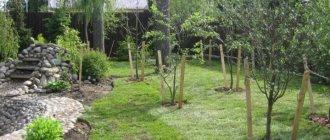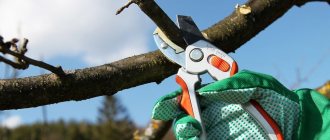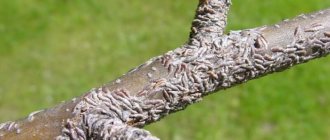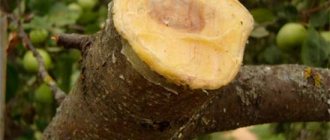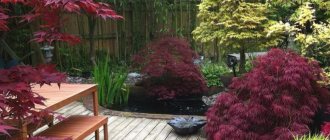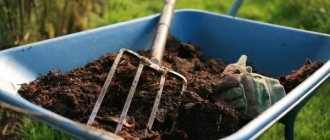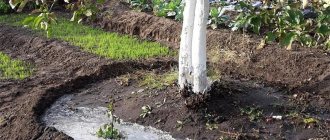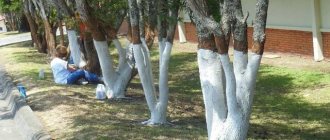Loading…
Loading…
Most summer residents try to create an ideal landscape on their site, reminiscent of the Garden of Eden. An important step towards the goal is rejuvenating tree pruning, which gives the plant a second life. Thanks to the procedure, internal genetic processes are launched. This leads to the emergence of new branches. Ornamental crops acquire an attractive appearance, and fruit crops produce abundant harvests. What can help gardeners do pruning correctly? What principles should be followed when performing work? How to give an old garden new life? Let's find out what the experts say.
Anti-aging tree pruning from a scientific point of view
All plants on earth are subject to the aging process. This leads to internal and external cultural changes:
- the trunk is deformed;
- the branches dry out;
- growths appear;
- cracks form;
- fruiting stops.
Old trees cause negative emotions, so they are simply removed from the site. However, there is another way to solve the problem, which returns the plant to its former beauty. It’s not for nothing that the good old song says: “And even a stump... dreams of becoming a birch tree again.” We are talking about rejuvenating tree pruning, which even an inexperienced gardener can do.
The essence of the procedure is to stimulate the internal processes of the plant. As a result, dormant buds come to life and new shoots appear. When they get stronger (about a year), they are thinned out again. As a result, the growth rate increases.
When pruning one-year-old branches, it is advisable to leave 2-4 lateral buds.
After a season, the main skeleton of the plant is formed from powerful branches. To do this, remove elements that thicken the space between the shoots. In addition, anti-aging pruning of trees is used to form a compact crown. Otherwise, it will look like a shapeless broom. The crop will grow a huge number of small shoots that lack flower buds. The yield of fruit trees will decrease significantly. The fruits will have a faded color and various growths.
Armies of pests often settle in the thickened crown of a tree, which gradually kill it.
Who can order rejuvenating tree crowning in Moscow?
In a metropolitan area, such pruning is permitted only by professional arborists. Our employees have permission to work at heights. They trim large trees using climbing equipment. Arborists also use special vehicles (auto-towers - auto-hydraulic lifts that lift the cradle to various heights).
If you need anti-aging pruning in Moscow or outside the capital quickly, professionally and at an affordable price, we will fulfill your order. We serve both individuals and corporate clients. Contact us, we will be happy to help!
Basic principles of a simple procedure
Proper pruning of fruit and ornamental crops includes two simple techniques:
- shortening branches;
- thinning (removal of the entire shoot).
Agronomists advise ideal plant parameters. Maximum height - 3 m, width - up to 5 m. The crown should be transparent, reflecting an openwork shadow on the ground. This approach is actively used in the formation of low-growing fruit crops. For stone fruit and pome trees, a sparsely layered crown is created.
The procedure for pruning old trees for rejuvenation is carried out under the following factors:
- high level of crown density;
- decrease in yield;
- serious illnesses;
- insect pests.
Particular attention is paid to annual growth. It is determined, firstly, by the color of the shoot. It is slightly lighter than its neighbors. Secondly, young shoots have a soft structure. After all, she has not yet become woody. The growth of pome trees ranges from 10 to 15 cm. Stone fruit crops boast a shoot length of about 30 cm.
Rejuvenation work is carried out in early spring, if severe frosts are a thing of the past. The temperature can be reduced to -5°C. Lower values have a detrimental effect on wood. It becomes fragile, and the cuts become embossed.
The pruning time is chosen taking into account the climatic conditions of the region.
Rejuvenation of stone fruit trees
Sweet cherries are rejuvenated during the harvesting process. The central conductor is cut at a height of 4 m. It is transferred to a side branch. Skeletal processes are shortened above the shoots looking away from the trunk. This is done to open the crown.
Apricots are young in spring and summer, but they are ready before June 5th. Subject to gentle, non-radical pruning, the apricot will give very good growth and will be able to lay fruit buds on the shoots of the second stage.
Plant height correction
There are various ways to rejuvenate a tree and restore it to its former beauty. The maximum height of fruit crops should be no higher than 2.5 m. Old specimens do not meet accepted standards. Therefore, to rejuvenate a tree, first of all, the top and several thick branches are cut off. The cut is directed towards the periphery at an angle of approximately 50°. All branches are removed at a height of 2.5 m. Next we move on to the skeletal elements. They are shortened by 2 times so that they grow horizontally to the trunk. All vertical elements are removed forever.
The next step leading to a reduction in the height of the crop is thinning out the lush crown. First of all, remove:
- dry shoots;
- diseased elements;
- underdeveloped branches.
Next, intersecting shoots are cut off, as well as those directed towards the trunk. Inside the crown, branches that create a strong shadow are selected, after which they are cut down. Thanks to the procedure, the fruit crop is gradually renewed and will even bear fruit over time.
Rejuvenation of an old garden
Having become the owners of a plot of land in the village, we naturally thought about a garden. We bought the plot not for a dacha, but for permanent living, but it was not possible to move right away, so we spent a year and a half visiting: when we arrived, we tried to look around, and when we left for the city, we dreamed and planned. We read about varieties of apple and pear trees and dreamed about apricots and cherries. Why not: it grows in the Moscow region, and we are even further south.
Anti-aging crown pruning
An important step on the path to the revival of culture is the shortening of perennial branches. The procedure begins from the periphery. The lower specimens are directed upward. Those in the middle are shortened by 2 times. They should go to the side, perpendicular to the tree trunk. In this case, the main shoot should be slightly longer than the small branches. The maximum length of branches is from 45 to 60 cm, depending on the type of fruit crop.
It is advisable not to touch the thick shoots located below. Large wounds weaken the plant’s immunity and often lead to its death.
Restoration and formation of fruiting shoots
Old trees with a living root system are able to bear fruit. To do this, they undergo anti-aging pruning in the traditional way. Old skeletal branches are removed to a side shoot. In annual specimens, an external living bud is left. Thanks to this, the productivity of the fruit crop increases. Next, additional measures are performed using various supports.
In early June, the young branches of the first and second tiers are tilted down and tied to the main trunk of the plant. The side branches are secured to supports so that they extend into a horizontal position.
It is not advisable to cut annual elements short. Otherwise, the crown will quickly thicken and delay the fruiting process.
Rejuvenation procedure at low temperature
Every gardener tries to cultivate his property in a plant-friendly way. The best solution is to carry out rejuvenating pruning of old trees in winter according to the traditional method. The procedure is carried out at a temperature of -5°C if the weather is relatively warm for a long time. During this period, the trees are dormant. All its processes are slow, so the plant will easily tolerate the procedure.
Winter anti-aging pruning is suitable for the following frost-resistant crops:
- Apple tree;
- pear;
- plum;
- apricot;
- cherry;
- quince.
Before starting work, gardeners analyze the weather forecast for the week. If temperature changes are expected, it is better to postpone pruning.
Under optimal conditions, instruments are prepared:
- pruner;
- hacksaw (fine-toothed);
- lopper
After a careful inspection of the crops, they get down to business. First, diseased shoots are removed. Then, those that grow near the base of the trunk. Next they move on to rejuvenation and thinning of the crown. They also cut off branches directed towards the inside of the tree. Large sections are treated with white oil paint.
Clusters of insect pests found on crops must be removed immediately.
Spring rejuvenating tree pruning
If a tree does not bear fruit for a long time, it is removed from the site or given a new life. Of course, cutting down a plant is the last thing to do. Why not fight for it? In gratitude, it will bring a bountiful harvest.
To achieve the goal, rejuvenating cleaning of trees is carried out. In the spring it begins before the active movement of sap. A suitable temperature is about 5°C below zero. First of all, carefully remove damaged and diseased specimens. Next, the thick crown is cleaned and the shoots that disrupt the skeletal structure of the plant are cut down. Do not forget to shorten annual growths.
Particular attention is paid to the kidneys so as not to accidentally hit them with a sharp blade. The procedure is performed with pruning shears. It is placed on the opposite side of the branch at an angle of approximately 45°. The blade is placed just above the base of the kidney. The optimal distance is 2 mm.
When the shoot is completely removed, a ring without knots is left on the crop. Thick specimens are first cut from the back, and then from the top.
Deep pruning or how to crown trees correctly
Crowning is the pruning of drying, overgrown or weak branches, after which the tree rejuvenates. This procedure improves both the appearance of the plant and its internal condition. Thinning the crown helps increase access of air and light to the leaves. And this, in turn, allows us to activate photosynthesis in cells.
Over the years, the uncut green “cap” grows. A tree, during its life cycle, becomes potentially dangerous to people and property. This is especially true for densely populated cities. Therefore, anti-aging pruning of the crown must be urgently performed when the crown:
- lies on the roof of the building;
- got tangled in electrical wires;
- has excessive windage;
- consists of an abundance of rotten, damaged or broken branches.
Every year it is necessary to carry out rejuvenating pruning of diseased, damaged branches. Branches that are turned inward or rub against each other must also be removed. In addition, shoots growing at an acute angle to the trunk must also be removed once a year (except for pyramidal plant species).
"Return to Eden"
Often, elderly parents leave their dacha property to their children. Typically, such areas contain fruit trees planted many years ago. Let's look at how to tidy up an old garden and enjoy its beauty for several decades.
After a thorough inspection of the trees, they get down to business. The first to remove are the old branches of the lower tier, in which there is barely a glimmer of life. They stopped developing long ago due to lack of sunlight. After all, viable branches “moved” to the upper floors.
Next, each trunk pointing toward the sky is evaluated. The sentence includes:
- a bare branch with a broom-like top;
- shoots with damaged bark;
- huge specimens protruding from the crown.
Now the culture looks much more attractive. The remaining elements are the basis of the future tree. Thanks to this “unloading”, it will produce young shoots all season long. And in the fall or spring, they begin the next pruning according to the traditional pattern. In a few years, the old garden will turn into Eden, where you always want to return.
Let's summarize. Even old trees have hope of coming back to life, delighting people with fruits. To do this, there is a well-thought-out scheme and basic principles of anti-aging pruning that should be followed. It is important to take into account the age of the plant and its characteristics. Then even the oldest “old man” will look at least 10 years younger.
Restoration of old trees
Most modern gardeners treat their green wards responsibly and take care of the garden in a timely manner, preventing the deplorable condition of the trees. However, it also happens that the newly purchased plot already has an orchard, and it is not in the best condition. Then you have to master the skills of tree rejuvenation.
It is always worth starting with putting the garden in order and minimal sanitary treatments. Regardless of the time of year, remove the root shoots, water, loosen and mulch the tree trunks, clean the trunks and branches of moss and lichens, carry out seasonal feeding and treatment against pests and diseases. As a rule, trees in an old orchard have many problems, and this may be the reason for the decline in fruiting.
If the activities carried out in the first year did not help, proceed to more radical actions.
Timing for pruning old apple trees
It is recommended to rejuvenate fruit crops not at once, but over several years. Spring, as well as the autumn period, are considered by experts to be the most optimal time for carrying out rejuvenating activities.
The main signs of the need to rejuvenate an apple tree: an abundance of dry branches, cracks in the trunk and low yield
In the spring season, before the sap moves in the plant, they begin to cut off unnecessary (old and diseased) parts of the crown. An old apple tree in comfortable conditions and at warm air temperatures can quickly recover and grow a fresh crown by winter.
When pruning in the fall, you need to wait until the tree stops bearing fruit, that is, the entire harvest has already been harvested and the leaves have been shed. At the same time, you should not wait until serious frosts.
Healthy! Provided that dead areas are removed in a timely manner, a fruit tree can stand for 20-30 years and bear fruit abundantly all this time.
Raise and narrow the crown of fruit trees
This method is suitable for old trees. You need to cut off all the small branches that grow downwards. The main rule is to cut to the first shoot or branch looking up. You also need to reduce the crown diameter. To do this, slightly shorten all the branches directed to the side.
It is important to reduce the branches to the length where strong growths of more than 50 cm appear. If there have been no good growths for a long time, then cut off all the branches that have grown over the past 5–6 years.
It is very important to maintain the hierarchy of branches. That is, the longest is the main branch. The thin branches that grow on it should be shorter than the main one.
What is the process of fruit tree rejuvenation?
Every gardener wants to have a beautiful, well-groomed and fruit-bearing garden. Fruit trees in Russia live for about 30 years - after that they must be uprooted. But what to do if the end of the term is still far away, and the trees no longer produce juicy and large fruits? It is for such situations that breeders have come up with several ways to rejuvenate trees.
Tree rejuvenation is a procedure carried out for a weakened tree that has ceased to produce the optimal amount of fruit. After these procedures, the tree will bear fruit with renewed vigor.
The main task of anti-aging pruning is to rid the tree of the burden of old branches. It will not waste energy on them and will put all the energy into fruit.
But when to prune fruit trees? In winter, the branches are too dry and brittle. In summer, the tree comes to life and if it is pruned, it may bleed sap. Experienced gardeners recommend pruning trees in the spring. It is at this time that the tree has not yet fully revived after winter, so it can withstand stress more easily. The second reason is that in the spring you can already determine which branches are dry and which are full of strength and ready to bear fruit.
The option of pruning trees in the fall is also not excluded. The main thing is to collect all the fruits so that the stress on the plant is minimal.
